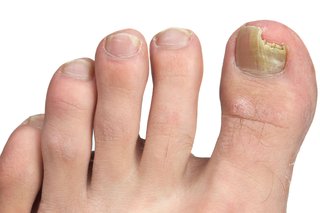Fungal nail infections are common. They're not serious but they can take a long time to treat.
Check if it's a fungal nail infection
Fungal nail infections usually affect your toenails, but you can get them on your fingernails, too.

john shepherd / Alamy Stock Photo

David Ridley / Alamy Stock Photo

David Schliepp / Alamy Stock Photo
Important
If you have diabetes, you should see a foot specialist because any foot injury can lead to complications of diabetes.
A pharmacist can help with fungal nail infections
Speak to a pharmacist if the look of your nail bothers you or it's painful.
They may suggest:
- antifungal nail cream – it can take up to 12 months to cure the infection and does not always work
- nail-softening cream – used for 2 weeks to soften the nail so the infection can be scraped off
The infection is cured when you see healthy nail growing back at the base.
Non-urgent advice: See a GP if your fungal nail infection:
- is severe and treatment has not worked
- has spread to other nails
Treatment for a fungal nail infection from a GP
Your GP can prescribe antifungal tablets. You'll need to take these every day for up to 6 months.
Tablets can have side effects, including:
- headaches
- itching
- loss of taste
- diarrhoea
You cannot take antifungal tablets if you're pregnant or have certain conditions. They can damage your liver.
Badly infected nails sometimes need to be removed. It's a small procedure done while the area is numbed (under local anaesthetic).
Other treatment
Laser treatment uses laser to destroy the fungus.
You'll have to pay for it as it's not covered by the NHS. It can be expensive.
There's little evidence to show it's a long-term cure as most studies only follow patients for 3 months.
Preventing fungal nail infections
Fungal nail infections develop when your feet are constantly warm and damp.
You're more likely to get an infection if you wear trainers for a long time and have hot, sweaty feet.
To prevent fungal nail infections:
Do
- treat athlete's foot as soon as possible to avoid it spreading to nails
- keep your feet clean and dry
- wear clean socks every day
- wear flip-flops in showers at the gym or pool
- throw out old shoes
Don't
- do not wear shoes that make your feet hot and sweaty
- do not share towels
- do not wear other people's shoes
- do not share nail clippers or scissors
Page last reviewed: 19 December 2017
Next review due: 19 December 2020
